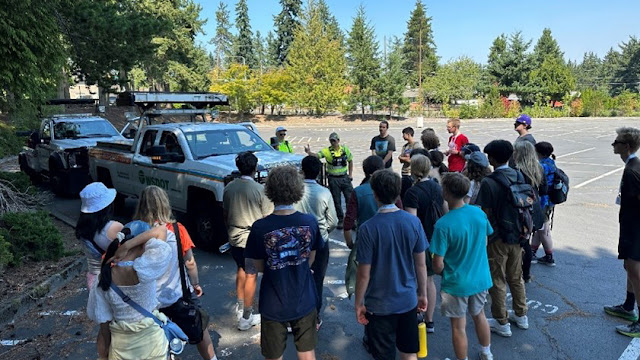By Sean Quinn
They say the choices we make today create the future that we are dreaming of. That’s why we include our younger generations to help us create a better future for transportation in our state!
This summer, we hosted two groups of high school students from across our state as part of the new and free PacTrans-WSDOT Summer High School Transportation Camps. For the first time, in partnership with the University of Washington, Washington State University and Pacific Northwest Transportation Consortium, we offered high school students a chance to spend a week exploring the challenges and opportunities their generation will face in the transportation field with statewide experts, leaders and frontline workers from our agency and university professors. Students stayed on campus in university dormitories during the camp and all lodging and meals were covered by sponsors so there were no costs to the students.
 |
| Students at our UW camp listen to IRT drivers Dennis Smith and Ray McLeod describe their daily work helping keep our highways safe. |
Learning how the system works
The goal of the camps was to address how we decide where transportation systems go, what we’re doing to reduce our carbon footprint and how we plan for the future of transportation and incorporate multimodal objectives while keeping people and goods moving. The students didn’t need previous experience in engineering or transportation – but curiosity was a must!
 |
| Secretary of Transportation Roger Millar spoke to campers at both the UW and WSU about the challenges and opportunities of our transportation system. |
With plenty of field trips to experience hands-on learning, the camps explored a wide range of transportation topics such as urban planning, traffic safety, environmental justice, geography, supply chain logistics and the future of connected and self-driving vehicles. For some students, this could be the start of a career in transportation, engineering, planning or a whole host of other fields. But even if it’s not, the teens gained a better understanding of how we all get where we’re going, as well as how the things we buy and need get to store shelves or our homes – and what goes into making those trips as safe and smooth as possible. They also got some pretty good stories to share with friends and family about the unique experience they had at camp.
 |
| Students at the WSU camp tried their hands in robotics by building a robotic car. |
Plenty to do
One group of students attended the camp at WSU in late July while a second group gathered at the UW in mid-August. While there were differences in experiences at each camp, many of the themes and some of the experiences were similar. Both camps heard from Secretary of Transportation Roger Millar, toured Transportation Management Centers in Shoreline and Spokane and heard from various leaders about the future challenges the transportation industry faces.
Each camp also took some unique field trips. Besides visiting some of our facilities near the campuses, the Seattle group toured facilities at King County Metro, Amazon and PACCAR and in Spokane they visited local ports to learn how produce grown on eastern Washington farms uses the transportation system to make its way to stores and tables.
 |
| Both camps visited our Transportation Management Centers, including this one in Shoreline, where they also toured our Emergency Operations Center and heard from engineer Kevin Radach. |
“It was just really cool to see how it all goes down – I’ve never seen such a large operation,” said Ollie, a student at the UW camp, after visiting the Shoreline Transportation Management Center. “It really puts into perspective the hard work that gets put in 24 hours a day, 365 days a year, keeping people moving from Point A to Point B.”
Some students were able to explore emergency equipment inside of multiple Incident Response Team trucks and watched the hundreds of live traffic cameras showing highways across the state inside the two transportation management centers. Some took a close look at one of our drones and survey equipment we use in 3D mapping, surveying, etc. Others visited engineering and chemistry labs, learned about traffic data analysis, worked on a robotic car group project and learned about how diversity and equity play a role in transportation planning.
 |
| Students at the WSU camp toured local ports to learn how agriculture grown in eastern Washington uses the transportation system to reach stores and our tables. |
Thinking forward
At the end of each camp, students were tasked with a final project showcasing their understanding of the challenges and opportunities present in transportation in our communities.
The summer camps not only provided the next generation of minds with valuable insights into the dynamic world of transportation, but also left them with everlasting memories and newfound skills. During the camps, the students engaged in hands-on experiences, explored new technologies, and learned from industry experts, all while meeting other students with similar interests and building their confidence. As they return back for the school year, they carry with them a deeper understanding of the role transportation plays in our lives and the exciting career opportunities that lie ahead. We hope their time with us ignited their passion for innovation, sustainability, and the ever-evolving field of transportation, inspiring them to become the next generation of leaders in this vital industry.
 |
| Jeremy Rinauro spoke to some of the WSU campers about his job as a project engineer and the changes in technology we’ve used. He explained how survey tools and drones are used in designing projects. |
Keep an eye out on our social media channels and our blog for future opportunities for camps should they become available. You can also learn more about the Pacific Northwest Transportation Consortium (PacTrans) on their website.
No comments:
WSDOT comment policy
Post a Comment